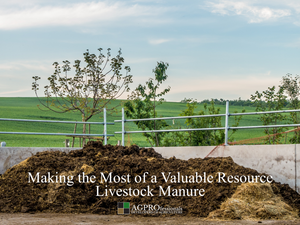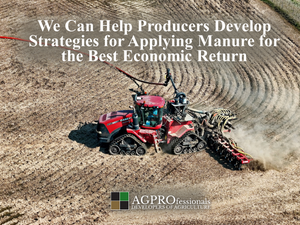Agronomy Articles
Livestock Manure: Turning a By-Product Into a Valuable Resource
Fact: Livestock producers manage a lot of manure. It’s odorous, abundant—and surprisingly valuable. When handled properly, manure becomes a powerful organic fertilizer that improves soil health, reduces input costs, and supports long-term sustainability.
Think about it: a single dairy cow can produce around 80 pounds of manure each day. Multiply that by a herd, and the numbers add up quickly. With such a plentiful resource, it makes sense to manage it wisely rather than view it as a waste problem.
Effective manure management comes down to three things: good records, reliable sampling, and a thoughtful nutrient management plan. Here’s how to make the most of it.
Understanding Manure’s Value
Manure contains essential nutrients—nitrogen, phosphorus, and potassium—that crops need to thrive. While “book values” published by universities and extension services can provide baseline estimates, relying solely on those averages can be risky. Nutrient content varies widely depending on animal diet, housing, storage, and handling methods.
That’s why regular manure testing is a best practice. According to the University of Minnesota Extension, relying only on book values can lead to over- or under-application of nutrients, reducing yields or contributing to water quality issues. Testing ensures:
moreDraglines Offer Best Economic Return from Manure Application
Manure happens. If you’re a livestock producer, you’re likely continually exploring ways to manage all that …, well, manure. Fortunately, AGPROfessionals is in the business of helping clients manage their … manure!
In this article, we take a look at draglines as an efficient method for application in your crop fields.
Draglines
Manure from dairies and feedlots is a valuable source of fertilizer, providing nitrogen and phosphorus to crops while increasing soil organic matter content. Manure can be applied to a field via broadcast methods, where manure is simply spread on top of the soil surface, or it can be “injected” below the soil surface. Regardless of whether manure is broadcast or injected, draglines have been shown to be the most efficient method of applying large volumes of manure.
Draglines are systems that pump manure from their storage location through a series of hoses that feed into an applicator on a tractor that then broadcasts or injects manure into a field. Draglines are commonly used by dairies to apply slurry since the liquid nature of the slurry allows it to be pumped through hoses. This method is more cost-efficient for larger dairies with crop ground near manure storage locations, as draglines allow the rapid transport of millions of gallons of manure slurry to a field but are typically limited to a 3-mile range. While the efficiency of the dragline system is difficult to beat, farmers must take care not to overapply manure to their fields and develop proper manure nutrient management plans.
more

